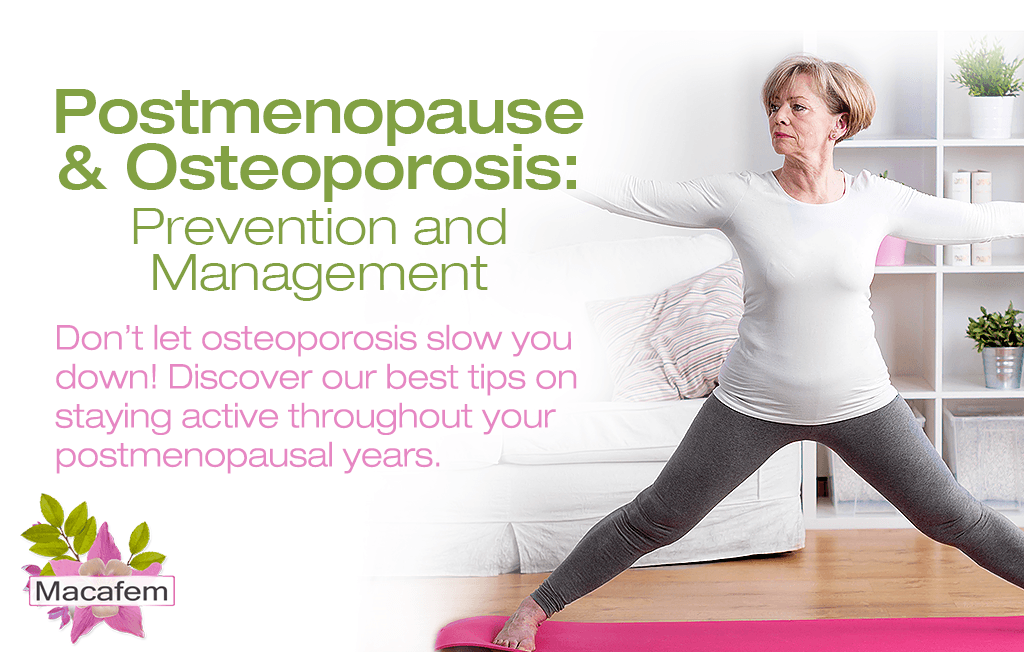Postmenopause & Osteoporosis: Prevention and Management
Alongside heart disease and weight gain, postmenopausal women are warned to keep an eye on their bone health. And for good reason. Studies estimate that one in two women suffer from fractures due to osteoporosis after menopause. Staying diligent and implementing a proactive approach can help prevent osteoporosis or stop its progression. Read on to find out all about postmenopause and osteoporosis to enjoy lasting bone health!

What Exactly Is Osteoporosis?
Osteoporosis is a progressive metabolic bone disease, characterized by low bone mineral density and reduced bone strength. As a result, bones become weak and fragile, significantly increasing the risk of fractures.
While osteoporosis affects both men and women, postmenopausal women are at the highest risk. In fact, the incidence rates of osteoporosis for women are higher than those of heart attack, stroke, and breast cancer combined.
Early stages of osteoporosis does not produce concrete symptoms. Many people find out they have osteoporosis after they break a bone. Advanced osteoporosis may cause back pain, changes in posture, and loss of height.
Does Menopause Cause Osteoporosis?
Menopause does not cause osteoporosis per se. Being postmenopausal, however, is a significant risk factor for the condition.
The reason why postmenopausal women are more prone to osteoporosis is the decline of estrogen levels as their reproductive years come to an end.
One of the roles of estrogen throughout reproductive years is to regulate bone metabolism. During the state of estrogen deficiency characteristic to postmenopause, there is more bone resorption than formation, resulting in osteoporosis.
Leading a sedentary lifestyle – which is common in postmenopause – is another important risk factor of osteoporosis
How to Prevent Osteoporosis After Menopause?
The likelihood of developing osteoporosis partially depends on factors beyond your control, like genetics. However, implementing a handful of wholesome practices to reduce common risk factors for osteoporosis can be highly effective in its prevention. Consider the following:
- Following a healthy diet is crucial for the prevention of osteoporosis after menopause. Opt for a balanced meal plan with ample amounts of calcium- and vitamin D-rich foods.
- Keeping up with daily exercises can effectively prevent or slow down the loss of bone mass. Focus on weight-bearing and muscle-strengthening exercises.
- Quitting smoking and limiting alcohol intake is an important step in preserving bone health as they may reduce calcium absorption and delay fracture healing.
- Reducing stress should be an important addition to your prevention plan as accumulated stress is a risk factor for osteoporosis. Find calm in breathwork, meditation, contact with nature, and more.
- Scheduling regular checkups – including undergoing a bone density test – is a great approach to preventing osteoporosis.
How Can I Treat Osteoporosis and Improve Bone Health After Menopause?
The choice of treatment for osteoporosis will depend on several factors, including its stage
- Wholesome lifestyle practices of a healthy diet, regular movement, and healthy habits mentioned in the previous section can do wonders when it comes to treating the progression of osteoporosis.
- Hormone-balancing supplements, like Macafem, may be a valuable tool in easing the effects of estrogen deficits on the body and slow down the progression of osteoporosis. It can be safely taken long-term.
- For advanced stages of osteoporosis, women may need medications to prevent fractures and disability. Surgery may also be recommended if medication treatment has failed.
Osteoporosis is a significant threat to your postmenopausal health. It should be taken seriously. By improving your habits, promoting hormonal balance with Macafem, and staying on top of your health, you can drastically reduce the risk of developing osteoporosis and enjoy being healthily active throughout your postmenopausal years.
Nature Reviews. Disease Primers. (2016). Postmenopausal osteoporosis. Retrieved November 7, 2022, from https://pubmed.ncbi.nlm.nih.gov/27681935/
Better Health Channel. (2019). Menopause and osteoporosis. Retrieved November 7, 2022, from https://www.betterhealth.vic.gov.au/health/conditionsandtreatments/menopause-and-osteoporosis
Menopause. (2021). Management of osteoporosis in postmenopausal women: the 2021 position statement of The North American Menopause Society. Retrieved November 7, 2022, from https://journals.lww.com/menopausejournal/Abstract/2021/09000/Management_of_osteoporosis_in_postmenopausal.3.aspx
National Osteoporosis Foundation. (n.d.). Osteoporosis Fast Facts. Retrieved November 7, 2022, from https://www.bonehealthandosteoporosis.org/wp-content/uploads/2015/12/Osteoporosis-Fast-Facts.pdf
Mayo Clinic. (2021). Osteoporosis. Retrieved November 7, 2022, from https://www.mayoclinic.org/diseases-conditions/osteoporosis/symptoms-causes/syc-20351968

